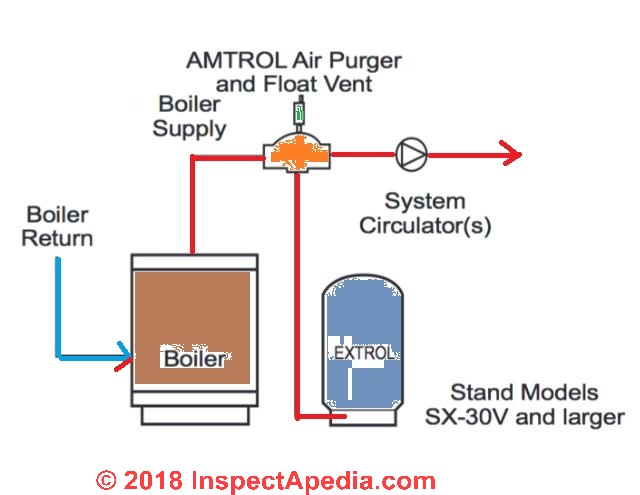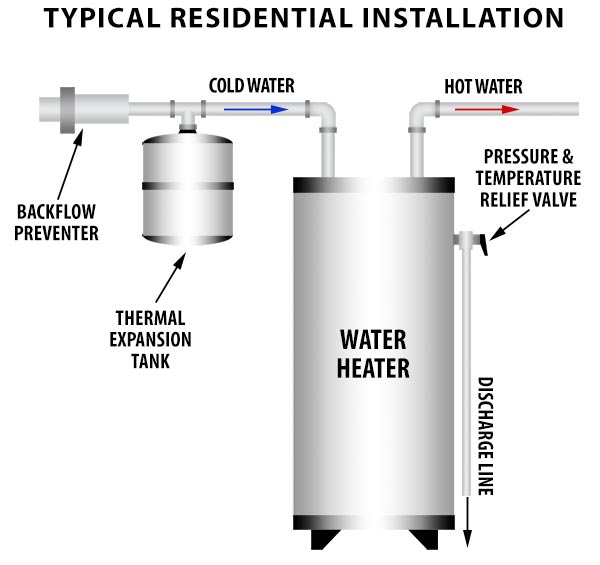Expansion Tank Installation Diagram
This tank must be installed according to your local plumbing code. It should be at least 18” from the cold water inlet to the water heater. A 150 PSI relief valve must be installed in the water heater. A pressure reducing valve may also be required if the incoming water pressure exceeds 80 PSI. This design and operation of this style of expansion tank allows the designer or specifying engineer to reduce tank sizes up to 80%. Compression Expansion Tanks ASME. Compression tanks are designed to absorb the expansion forces and control the pressure in heating/cooling systems.This tank is the oldest style that has been used in this systems.
A standard tank water heater can stress your plumbing pipes by the normal thermal expansion that happens during the heating process. A safety device known as a water heater expansion tank (sometimes called a thermal expansion tank) can help minimize the risk of pressure damage to the plumbing system. (This is normally not a problem on modern on-demand, tankless water heaters--only tank-style heaters are subject to this problem.)

The water heater expansion tank serves as an overflow receptacle by absorbing excess water volume created by the tank water heater when heating water, as well as absorbing fluctuations in the incoming water supply pressure. Since water expands when it is heated due to thermal expansion, the water heater creates extra water volume every time it heats water. It's estimated, for example, that the cold water in a standard 50-gallon water heater expands to 52 gallons when heated to 120 F. This extra water volume can create excess pressure in the plumbing system, and if the increased pressure is enough it may, over time, cause damage to the water heater, plumbing fixtures and the water pipes themselves.
Closed Water Supply Systems
In an open system where expanding water can push back into the city water supply, there is rarely any problem. However, many homes have a closed water supply system, which is a water system equipped with a one-way valve such as a backflow valve, check valve or pressure-reducing valve. In a closed system, this extra water pressure from thermal expansion can cause the most damage because the extra water pressure cannot push back into the city water supply and therefore has nowhere to go.
Most cities require that residential closed plumbing systems be equipped with expansion tanks. If you have some form of backflow preventer installed on the main water line, you may be required by law to also have a water heater expansion tank installed. Check the local building code or call the building and safety department to find out.
How a Water Heater Expansion Tank Is Installed
If you do not have a one-way valve installed on the main water line and therefore do not have a closed water system, you may still benefit from a water heater expansion tank. Expansion tanks are normally installed above the water heater on the cold water line before it enters the water heater; however, they can really be installed anywhere on the cold water line prior to entry into the water heater. Having an expansion tank helps prevent dripping faucets and running toilets by keeping the extra built-up pressure in the system from reaching the fixtures and prematurely damaging them.
Water heater expansion tank prices start at around $40 and range up to nearly $200; pricing is largely dependent on the size of the tank. For most residential installations with 40- or 50-gallon water heaters, a simple 2-gallon tank is fine. The tank is quite easy to install with a normal 3/4” threaded connection. A tee fitting will have to be installed above the water heater if one is not there already.
If you are hiring a plumber to have a water heater installed, it’s a good idea to get a price for the installation of an expansion tank at the same time. It may not be much more than you are already paying if it is done at the same time. If you are installing a water heater yourself, consider installing an expansion tank even if it is not required, since the benefits far outweigh the work and cost involved.
An expansion tank can help your water heater last longer and it may even be required in many areas. Many counties require a plumbing permit for installing a water heater so you can ask the building and safety department if an expansion tank is also required. As long as you have a place for an expansion tank on top of your water heater they are easy to install. Even if an expansion tank is not required in your area it can be a good idea to install one to prevent damage from thermal expansion. Installing an expansion tank is a moderate do it yourself project. If you are installing a new water heater yourself then it’s the best to install the expansion tank at the same time.
Watts Expansion Tank Installation
Parts required: All you will need (on top of the requirements for a normal water heater installation) is a ¾ x 4” galvanized nipple, a galvanized ¾” tee, a ¾” galvanized elbow, a short 2” galvanized nipple, pipe joint compound, and plumber's tape.
New Water Heater Installation: There are plenty of ways to plumb the expansion tank into the water heater, but the easiest method we have seen is with Galvanized pipe. It is inexpensive and easy to install. Some water heaters come with the nipples already in the water heater for the hot and cold water supplies. If these are not already in and tight then you will have to install them first. The expansion tank can go on the hot or cold side but it’s a good idea to check with your building department and ask which side they want it on because we have heard arguments for both and the requirements can go either way. When tightening the galvanized joints make sure to use two large pliers or two pipe wrenches because the joints will need to be tight. One wrench will be used to hold against the pipe you are tightening and the other is used to tighten the pipe or fitting.
- Install the galvanized tee on top of the water heater. Make sure to put plumber's tape and pipe joint compound on the nipple coming out of the water heater. Tighten the tee and make sure to face it in the direction you want the tank to go. You can always swing it a little once it is in place, but get it close to where you need it to make it easier.
- Next prepare the long nipple with plumber's tape on both ends. Put a little pipe joint compound over the plumber's tape. To make things easier tighten the elbow onto the nipple on the ground. Once it is tight then you can screw just the one side into the tee. When it is tight, make sure that it is facing straight up.
- Prep the threads on the expansion tank with plumber's tape and a brush of pipe joint compound. Now screw the expansion tank into the elbow. Go until the expansion tank is tight, it does not really matter which direction it ends up on.
- Last is nipple on top of the tee. Only the end going into the tee needs plumber's tape and pipe joint compound. Tighten the nipple into the tee. Now the water heater flex line will connect to the nipple. Sometimes the flex line will need to be flexed around to fit properly. A long flex line can even make a loop if necessary to make the connection.
Water Heater Expansion Tank Installation Diagram

Existing Water Heater Installation: Make sure there is plenty of room above the hot or cold side of the water heater for the expansion tank. The main difference when installing an expansion tank to an existing water heater is that you are removing the flex line first and installing the tee where it made the connection. Things can get a little tight and you may need to use a longer flex line so you can do a big loop or even a shorter water heater flex line if it makes it easier. It is often a good idea to change that flex line either way because they rarely go back without trouble especially when a change is made.